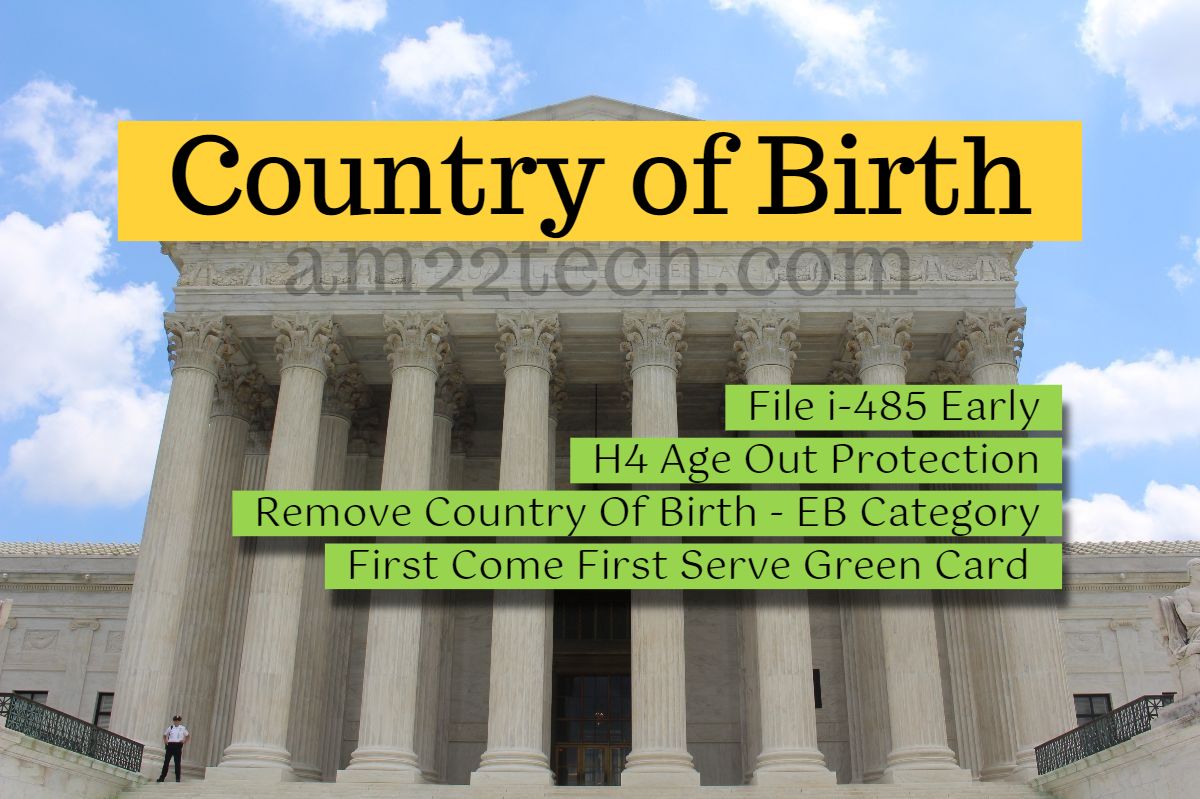|
Listen to this article
|
16 Dec 2022
The bill has been scrapped and has no immediate sign of revival.
- The Senate is already divided and it seems there is no real intention to actually solve the problem.
- The House will also be divided starting Jan 2023 and there is no real hope for at least the next 2 years.
You can play with this app to know how Eagle act provisions could have changed the expected visa bulletin date for your ‘priority date’ vs the current scenario.
Estimate Green Card date (with Eagle Act)
As we told earlier, the White House statement supporting the Eagle Act meant nothing and it has been proven so.
David Bier from CATO institute has proposed really good measures to give some relief to people stuck in this unending GC backlog, but keeping in mind the government’s past track record, all of them will need a big ‘change of heart’ to actually do anything.
This article will discuss:
Eagle Act (HR 3648) – House Version
Zoe Lofgren and John Curtis introduced the Eagle Act soon as the new version of S386 in Biden’s tenure. The Eagle Act has almost all the provisions that were part of the Durbin Lee compromise that passed the Senate in Dec 2020.
It can prove beneficial for employment-based workers if it becomes law.
The full text of the bill is available here in a PDF file on the house.gov website.
The bill aims to have the effective start date as the first day of the second fiscal year after it becomes law. This means that the earliest it can be activated is 1 Oct 2024 if it passes on or before 30 Sep 2023.
AI Passport & Visa Photos in Minutes!
No studio, no waiting. Get perfectly compliant photos from your phone.
✨ Get My Photo Now See how our AI transforms your phone photo into an embassy-ready passport picture!
See how our AI transforms your phone photo into an embassy-ready passport picture!The full form of Eagle is Equal Access to Greencards for Legal Employment as mentioned on ImmigrationVoice’s own website EagleAct.info.
#1 File i485 Quickly – First 9 years
You will be allowed to file an i485 application if
- Your PERM is approved and
- Your i140 has been approved for at least 2 years
The first 9 years will help move the already backlogged people into mainstream by letting them file the AOS (adjustment-of-status) so that they can get GC earlier than people who got in the queue later.
There will be Green card numbers reserved for Non-Backlogged countries (i.e. other than India, and China) for the first 9 years.
We have updated the Green card estimation app to check your estimated PD date based on the Eagle act (if it becomes law).
Estimate Green Card date (with Eagle Act)
Note that the first two years after the bill is passed will still observe the 7% country of birth limit. So, technically, year 3 (after the bill passes) is the first year for the 9-year rule to start:
- Year 1: 30% of GCs will be reserved.
- Year 2: 25% of GCs will be reserved.
- Year 3: 20% of GCs will be reserved.
- Year 4: 15% of GCs will be reserved.
- Year 5 and 6: 10% of GCs will be reserved.
- Year 7, 8, and 9: 5% of GCs will be reserved.
- Year 10 Onwards: No reservation for any country. A green card is now allocated on a first-come-first-serve basis.
#2 Remove country of birth green card limits
Removing the country of birth discrimination is the primary aim of this bill. This will be achieved in a phased manner and will take about 11 years to do so.
#3 H4 Age Out Protection
Children of Employment based Green card workers will not age out at 21.
#4 No increase in GC numbers
There is no provision to increase the total number of Green Cards.
#5 No ReCapture of lost Green Card numbers
There are about 220k lost green cards since 1992. This bill does not aim to recapture them.
Professional Visa Filing Service
Your trusted partner for a smooth application process.
Expert Support & Preparation
Get hassle-free visa extension and EAD filing professional support. Includes preparation, printing, photo editing, mailing and RFE preparation.
Fast & Efficient Service
Applications filed within 1-2 days with all documents ready. Emergency filing is also available to meet urgent deadlines.
Passport Photo Assistance
We professionally edit your photos to meet all US visa requirements, including background removal and proper alignment. Photo printing is included.
#6 Count H-1B dependents in Yearly Green card numbers
We could not find any text that points to a change in the counting strategy.
All these ideas have been floated earlier but never reached any conclusion in congress since the bill aims to achieve comprehensive immigration reform.
The intent is good and can help reduce the current backlog of about 500k green cards for Indian and Chinese communities but it will face challenges in convincing everyone.
Chances of Passing?
#1 Chance of passing House
The chances of passing the house are extremely high as the same bill passed in the House with a majority earlier in the form of HR1044.
We anticipate that it will pass again quickly in House with a good majority. The chance of passing in the house is 95%.
#2 Chance of passing Senate
Looking at the past S386 record which saw tons of amendments and could not become law even after passing the House and Senate, the chances of this comprehensive immigration reform are less than 10% at this time.
Last time, Senator Durbin had the hold on this bill for the longest time. The story in Senate was not encouraging as one after another Senator kept blocking it until it died with the Senate dissolution.
Timeline
There is no timeline and it can take years.
As they say, there are many slips between the cup and the lips, we still have a long way to go to see the light of the day without country-based discrimination. The bill will need to be passed by both House and Senate and then signed by President Biden.
Most H4 kids will age out if their parents cannot get a green card before they turn 21.
Should I Move to Canada?
The chances of getting a US green card for legal H1B workers from India are still a distant dream and you should have a backup plan until the comprehensive reform bill passes both House and Senate. There is no timeline for this and can take years.
People who took the decision to move to Canada, Australia, or the UK have taken the right decision. Canada and Australia already have a merit-based system in place and the UK started its own in Jan 2021.
The USA does not seem to care about legal skilled workers’ future. Our suggestions:
- If your non-US citizen kid is 15 years today, it is better to start planning to move to one of the above-mentioned countries unless the kid plans to marry a US citizen/Green card holder.
- If you are below 39 years of age, file for Canada, Australia, or UK Permanent residency immediately as you will find it difficult to get an invite if you don’t.
- If you are above 40 years today and do not have any other backup, you have probably missed the bus and have no other option than to keep waiting in the USA green card queue.
- If your child is 17+ years today, send them to Canada for studies and not the US. They can get Canadian residency more easily than lingering in the USA F1 and then H1B line like you.
CIS analysis report
Earlier in March 2020, CIS published the analysis report by the Congressional Research Service which claims that ‘country of birth removal’ will not stop the growth of backlogs in the future.
This report describes:
- The 10-year impact of eliminating the 7% per country ceiling on the first three employment-based immigration categories: EB1, EB2, and EB3.
- It has the potential of eliminating the Indian & Chinese EB1, EB2, and EB3 backlog in 3, 17, and 7 years respectively.
- It may just help reduce the Green card wait times for Indian and Chinese nationals initially but it would create a backlog for other countries.
If there is no removal of the country of birth GC limits, the CATO institute projects that this employment-based backlog will double by FY 2030 to 2 million as compared to the current 1 million.
Immigration Reform Passing Process
- Pass Senate and then House (If both are voting on the same exact version).
- Pass House and then Senate (If both are voting on the same exact version).
- President Signature: The final step after both Senate and House approval is President’s sign.




